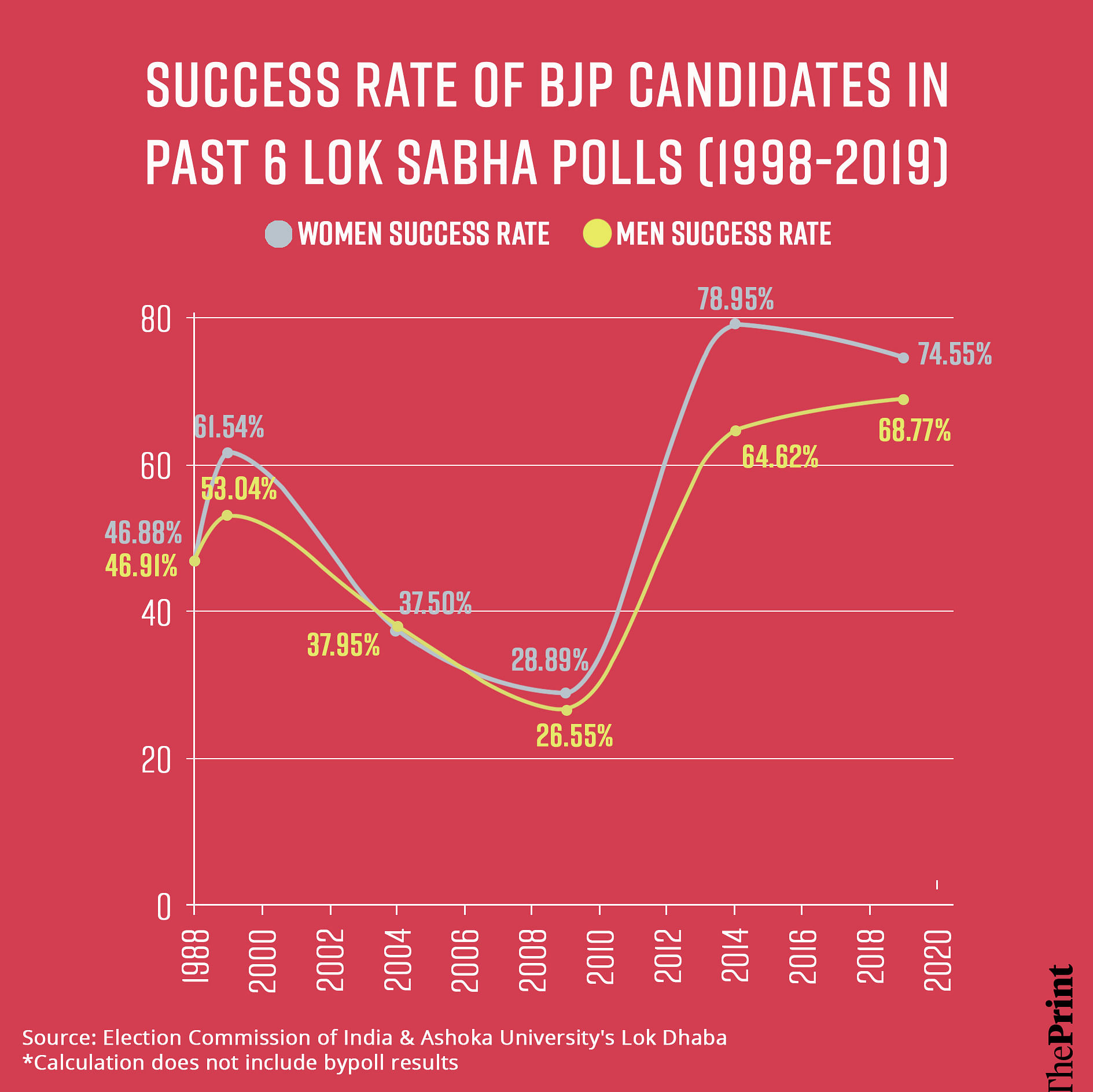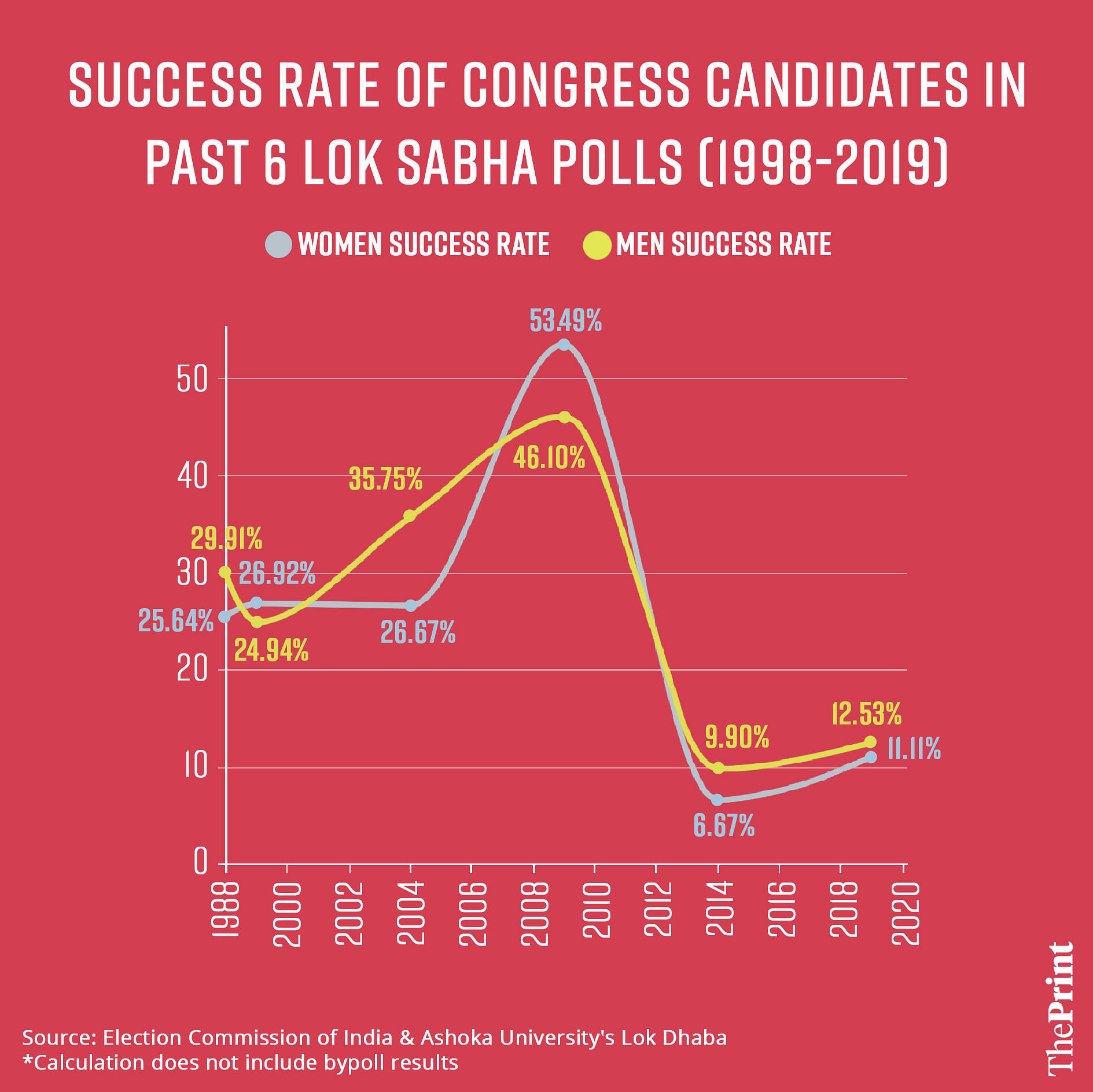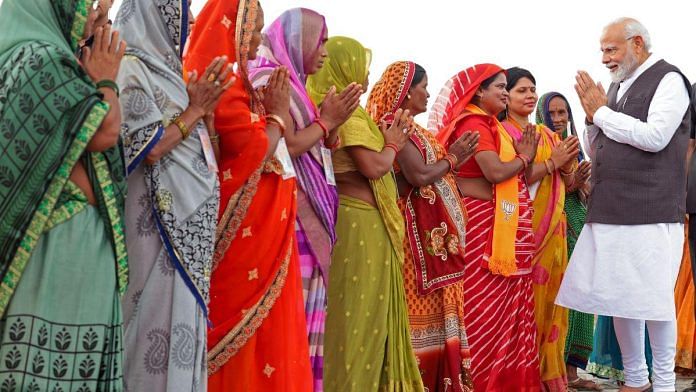New Delhi: Women candidates of the Bharatiya Janata Party (BJP) outperform their male counterparts when it comes to winnability, an analysis of the past six Lok Sabha elections (1998-2019) by ThePrint shows.
Their success rate was better than that of men in four elections and at par in two. Success rate in this analysis has been calculated by looking at the total number of candidates of a gender who won, over total candidates of that gender fielded.
ThePrint looked at the performance of women candidates in all the general elections held since the women’s reservation bill — cleared by the Parliament last week — was first introduced by the H.D. Deve Gowda government in 1996. Calculations did not take into account bypoll results.
Over the years, the bill was brought to parliament multiple times, but failed to sail through. While BJP has reportedly claimed to be the champion of women empowerment with the passage of the bill, the Congress has stated that the bill is their “child”.
In the last two elections, held in 2014 and 2019, when Narendra Modi became the party’s face, the success rate of female candidates improved significantly — from 29 percent in 2009 to 79 percent and 75 percent in 2014 and 2019, respectively.
Out of 38 female candidates the BJP fielded in 2014 Lok Sabha election, 30 won. In 2019, of the 55 fielded, 41 won. There was a significant rise in female candidates’ success rate in the 1999 Lok Sabha election, too, when then Prime Minister Atal Bihari Vajpayee was the party’s face. The BJP had fielded 26 female candidates then, of which 16 won.
In the 2019 Lok Sabha election — when the BJP fielded 55 female candidates, 12.61 percent of the total number of candidates — every three out of four BJP women candidates won their seats. Their success rate was 75 percent as against 69 per cent for male candidates.
It was even better in 2014 when 79 percent female candidates won their seat; it was 65 per cent for men.

These data give an indication of why BJP leaders have been showcasing the women’s reservation bill, which provides for one-third reservation of seats for women in the Lok Sabha.
At a meeting of BJP workers in Madhya Pradesh, PM Modi had attacked the Opposition, saying, “Women have become stronger in the past nine years… Seeing this, these parties did not have the courage to oppose the Bill. Why could they not pass this Bill even when they had a majority at the Centre?”
In the Congress, men outperformed women in the 2019 election in terms of their success rate — 11.11 percent for women and 12.53 percent for men. In 2014, Congress’s male candidates had a success rate of 9.9 per cent as against 6.67 per cent for women. However, the party has always fielded a higher percentage of women candidates compared to the BJP over the past 25 years, except in 2009 and 1998.

During these 25 years, despite a relatively healthy success rate, of all Lok Sabha parliamentarians, women from both parties accounted for around 10 per cent.
According to Prof Sanjay Kumar, co-director of Lokniti, a Research Programme at the Centre for the Study of Developing Societies (CSDS), the reason for women not coming into parliament in large numbers is that most political parties just don’t give tickets to women candidates.
In 1998, the Congress fielded 39 female candidates, in the next four their numbers were 52 (1999), 45 (2004), 43 (2009), 60 (2014) and 54 (2019). For the BJP, the number of female candidates went from 32 in 1998 to 26 in 1999, 32 in 2004, 45 in 2009, 38 in 2014 and 55 in 2019.
On the potential advantage of women’s quota earning the BJP political dividends, Kumar said, “Women as a vote bank has not emerged. But the BJP does not lose anything. The BJP is a gainer for the next 10-20 years because they would get the credit of getting the bill passed. Look how socially desirable this bill looks. All members but two voted in its favour. Therefore, they do not lose anything.”
“As of now, there is no difference in the women vote bank. Will women be happy with this bill and the BJP? Of Course, yes. So, if at all there is emergence of such a vote bank, it will be favourable for the BJP,” he added.
BJP’s women outreach
As the 2024 Lok Sabha elections approach, BJP and other parties are expected to scale up their outreach to women voters considering that turnout of women voters was slightly higher than men in 2019 elections, as media reports show.
Just a month before the women reservation bill was introduced, the Modi government had slashed the prices of domestic cooking gas cylinders by Rs 200 in late August. Earlier this month, it extended the benefit of Pradhan Mantri Ujjwala Yojana (PMUY), to 75 lakh additional connections, taking the total number of beneficiaries to 10.35 crore. The scheme launched in 2016, provides free gas connection for cooking to deprived households, who earlier relied on woodfire.
“The PMUY scheme has empowered women economically and socially,” said the Modi government in a press statement. His 15 August speech, too, focused on women with the PM pitching for women-led development ahead of the 2024 general elections and lauding women self-help groups (SHGs).
Modi added that 10 crore women are associated with SHGs and his dream is to make 2 crore ‘lakhpati didis’ in villages.
Back in 2014 itself, in his first year as PM, the Modi government had launched the Swachh Bharat Abhiyan, under which, it has, till now, constructed over 11 crore toilets. A year later in 2015, he launched the Beti Bachao Beti Padhao scheme to “protect the interest of the girl children and ensure their education”. Its support for the Uniform Civil Code (UCC), criminalising Triple Talaq and nullification of Article 370, have all been pitched by BJP as ways to empower women at some point or other.
(Edited by Zinnia Ray Chaudhuri)



